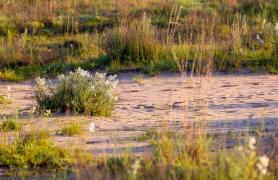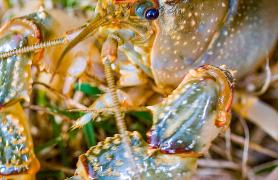Flip through any outdoors magazine or tune in to your favorite hunting show and you’ll quickly realize that there’s no shortage of ways to spend your money on habitat improvement. This might lead many to believe the only way to attract and hold strutting toms and big bucks is to spend big bucks, but that is not the only way to improve habitat for wildlife.
While most ads for food plot mixes or habitat management implements suggest that these tools are crucial to success, there are many ways to improve your land to provide the cover and food that wildlife needs.
If food plot mixes, specialized equipment, and big budget habitat enhancements are beyond your financial comfort level, take heart. Commercial food plot blends may attract wildlife, but native forbs, seeds, fruits, and woody browse are just as likely to do the trick. And the beauty of this approach is that often you do not need to purchase a single seed — just create the proper conditions for native species to flourish and then let them fill in and do their thing.
The Land Management Toolbox
Decades ago, before any of these big budget items were even concepts, conservationist pioneer Aldo Leopold recognized that there were basic tools and techniques for improving habitat for wildlife. In his seminal work Game Management, Leopold penned,
“The central thesis of game management is this: game [wildlife] can be restored by the creative use of the same tools which have heretofore destroyed it — axe, plow, cow, fire and gun.”
At a time when many wildlife populations were at an all-time low, he recognized that a tool used inappropriately is dangerous, while that same tool, used properly, can be beneficial. These tools identified nearly 100 years ago still form the core of our habitat management toolbox today.
To understand how we can benefit the land and its native flora and fauna, let’s unpack the toolbox and take a closer look at each tool and its proper use.
Axe
The axe represents our ability to modify habitat by removing or altering woody vegetation. Using the axe and its surrogates (chainsaw, brush cutter, forestry mulcher), we can modify habitats to favor the growth of early successional vegetation (See Early Successional Vegetation), increase browse, promote forest health, and remove invasive species. Habitat management techniques related to the axe include timber stand improvement (TSI), edge feathering, and planned forest harvest.
Plow
The plow relates to the use of implements to shift plant communities from advanced stage, perennial-dominated systems to younger communities with more annual plant species. It is most often used in herbaceous communities and is usually carried out with the use of a disk, rototiller, harrow, or plow, but could also include the use of a bulldozer and other equipment. Habitat managers recommend early successional vegetation for wildlife such as northern bobwhites, white-tailed deer, dabbling ducks, and turkey. The plow and its variants can be an important tool for promoting the plant communities these species favor.
Cow
Applied incorrectly, grazing, as represented by the cow, can result in the elimination of cover, erosion, nutrient overload, and loss of diversity. But make no mistake, when used properly, grazing can be a powerful habitat management ally. Many of Missouri’s ecosystems evolved in the presence of bison, elk, and other ungulates. Today many of our historic grazers have been replaced with the cow. And while bovine behavior may be somewhat different from the grazers of centuries past, the overall effects can still be positive as properly applied grazing can alter plant dominance, reduce thatch build up, cycle nutrients, and sculpt vegetative structure.
Fire
No other tool at our disposal has the potential to be as cost effective and costly at the same time as fire. It played an integral role in the development of Missouri’s prairies, glades, woodlands, and savannas, and its use by Native Americans and early pioneers resulted in plant communities that were diverse, robust, and attractive to scores of wildlife species. Fire removes thatch, resets the successional calendar, attracts herbivores to the fresh regrowth, and sets back certain species while enhancing others. Savvy managers know that fire can be the cheapest management tool, but also can be dangerous and very expensive if not done properly. Do not attempt to use this tool unless you’ve received training in its application and have plenty of help.
Gun
In Leopold’s day, unregulated market hunting caused the extinction of some species and threatened the fate of others. Thanks to game laws that set seasons and limits on what hunters could harvest, as well as wildlife science that continuously refines and informs management decisions, today we enjoy robust populations of several game species. In fact, in parts of Missouri, especially near urban areas, an overabundance of some species such as white-tailed deer and Canada geese may negatively affect habitats. In these cases, more harvest may be necessary to slow population growth and balance the herd with the habitat.
Herbicide
There is one tool commonly used today that Leopold did not mention by name. At the time of his writing, herbicides were still several years from popular use, but had they been more available, he likely would have included them in his list. As with all the other tools we’ve covered, herbicides can have positive or negative effects, depending on their application and use. Habitat managers should always read, understand, and follow the label for application rates and techniques. Herbicide chemistry and technology offer great potential for succession management and invasive species control, if they are used properly.
Early Successional Vegetation
Succession is the change in a plant community over time. Think about what would happen to a field if you were to till it up and then leave it alone for 20 years. In the first year, you would see lots of annual plants — those that grow, flower, and die in a single growing season. The next year you would still have some annuals, but also some perennials. By the fifth year you would likely have some woody plants such as blackberry, as well as young trees starting to show up.
By year 10 without disturbance, you might see a young forest or a community dominated by perennial grasses such as tall fescue, and so on. At each stage, the plant community will be different in terms of the food and cover available to wildlife. In late successional stages, plant diversity may be low, and most browse may be out of reach of many wildlife species (e.g., at the top of a tree). By contrast, early successional communities are typically rich in species diversity, with several dozen plant species providing an array of food, cover, and structure. Due to the nature of annual plants’ life cycles, they must produce lots of seeds to ensure their species’ survival and the perpetuation of their genetic material. Because of the diversity of species and their propensity for seed production, early successional communities are preferred by many popular wildlife species such as bobwhites, turkey, deer, rabbits, and doves.
Diversity Brings Success
Managing habitats this way also provides a diversity of plants to meet the dietary and cover needs of wildlife. With single-species commercial mixes, poor growing conditions (e.g., drought, flooding) may leave you with little or no production. But using an approach built on promoting diversity provides built-in insurance against failure. In a community with many plant species, there will always be species that produce, regardless of the weather.
In addition, native species are well adapted to the soils on your farm, meaning they will often thrive even if conditions are not ideal. So, you can save money on fertilizer and lime and invest those funds elsewhere for other improvements. And last, but certainly not least, many nontarget wildlife species (e.g., pollinators) may also benefit more from a diverse plant community versus a low-diversity planting. Native pollinators have received a lot of press lately, and rightly so, for they provide ecological services of inestimable worth. Using these tools, alone or in combination, we can transform our lands into productive oases for numerous species. A diverse native plant mix has additional benefits:
- Time efficiency. This approach works well for landowners who may live several hours from their farm. Rather than fret over the need for multiple trips and perfect weather, managers can go in and do the work to set the stage for growth of the native species. After that, there’s no need to worry about it anymore, as nature will do the rest. This approach saves time versus having to make multiple trips to work ground, plant, fertilize, spray, etc.
- Cost effectiveness. Instead of investing hundreds or thousands of dollars in high cost seed, fertilizer, and implements, you can instead invest a few bucks in fuel for a tractor or ATV to encourage natural regeneration and early succession vegetation. Or plan and execute a prescribed burn to realize a beneficial shift in the plant communities on your farm.
- Improved land stewardship. You’ll become more in-tune with your farm and the dozens of plants and animals that respond and result from your efforts. And this approach encourages you to learn to identify native plants and their growth habits, as well as better understand species’ responses to habitat management.
- Forgiveness. No matter what you do, some variety of plants, and their associated wildlife, will respond to your treatment. Burn too hot, too early, too late, or disk too deep, etc., and nature will fill the void you’ve created with multiple species adapted to those conditions.
Surprising Results
In 2012, I converted about 20 acres of fescue pasture on my farm to native grasses and forbs. In addition to the bluestems and native forbs that began growing that year, I created an ideal growing situation for redroot amaranth. Despite the severe drought that year, in the absence of sodgrass competition, one plant grew to a robust 5 feet tall, with a stem as thick as a broom handle. This plant was readily evident from even several hundred yards away and continued to attain impressive proportions until early fall, when I noticed it was no longer standing tall in the field. I found that some deer had finally decided to investigate its palatability and within a few days had completely stripped it of its leaves and the tips of the shoots, thus reducing it to a single sorry-looking stem. This illustrates how a plant many think of as a weed may be an important food or cover source for the wildlife on our lands.
Whether your habitat management aspirations are limited by cash or time or both, there’s still a lot you can do to improve habitat and foster the wildlife on your land. This year why not unpack your manager’s toolbox and try a few of these techniques, alone or in combination, and see for yourself what they can do. The results may surprise you.
Getting Help with Your Habitat Management Needs
Missourians have plenty of options when it comes to getting help with their conservation projects. Whether your needs entail cost share, technical advice, species identification, or engineering chances are free help is available. More information on property management is available online at mdc.mo.gov/property/ improve-my-property. To find a private lands conservationist near you, go to short.mdc.mo.gov/ZQ5 or contact your local regional office online at short.mdc.mo.gov/ZoF.




















Also In This Issue


And More...
This Issue's Staff
Editor - Angie Daly Morfeld
Associate Editor - Larry Archer
Staff Writer - Bonnie Chasteen
Staff Writer - Heather Feeler
Staff Writer - Kristie Hilgedick
Staff Writer - Joe Jerek
Art Director - Cliff White
Designer - Les Fortenberry
Designer - Marci Porter
Photographer - Noppadol Paothong
Photographer - David Stonner
Circulation - Laura Scheuler






















